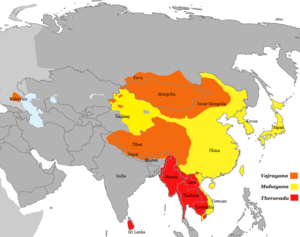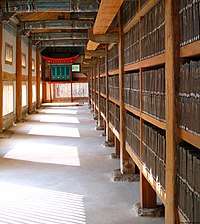East Asian Buddhism
East Asian Buddhism or East Asian Mahayana is a collective term for the schools of Mahāyāna Buddhism that developed in East Asia and Southeast Asia and follow the Chinese Buddhist canon. These include the various forms of Chinese Buddhism, Japanese Buddhism and Korean Buddhism in East Asia, as well as Vietnamese Buddhism in Southeast Asia.[1][2] Besides being a major religion in these four cultural regions, it is also a significant religion in Singapore and Malaysia. East Asian Buddhists constitute the numerically largest body of Buddhist traditions in the world, numbering over half of the world's Buddhists.[3][4]


East Asian forms of Buddhism all derive from sinicized Buddhist schools that developed between the Han dynasty (when Buddhism was first introduced from Central Asia) and the Song dynasty, and therefore they are influenced by Chinese culture and philosophy.[5] Some of the most influential traditions include Chan or Zen Buddhism, Pure Land Buddhism, Huayan, Tiantai, and Chinese Esoteric Buddhism. These schools developed new, uniquely Asian interpretations of Buddhist texts and focused on the study of Mahayana sutras. According to Paul Williams, this emphasis on the study of the sutras contrasts with the Tibetan Buddhist attitude which sees the sutras as too difficult unless approached through the study of philosophical treatises (shastras).[6]
The texts of the Chinese Canon began to be translated in the second century and the collection continued to evolve over a period of a thousand years, the first woodblock printed edition being published in 983. The modern standard edition is the Taishō Tripiṭaka, produced in Japan between 1924 and 1932.[7]
Besides sharing a canon of scripture, the various forms of East Asian Buddhism have also adapted East Asian values and practices which were not prominent in Indian Buddhism, such as Chinese ancestor veneration and the Confucian view of filial piety.[8]
East Asian Buddhist monastics generally follow the monastic rule known as the Dharmaguptaka Vinaya.[9] One major exception is some schools of Japanese Buddhism where Buddhist clergy sometimes marry, without following the traditional monastic code or Vinaya. This developed during the Meiji Restoration, when a nationwide campaign against Buddhism forced certain Japanese Buddhist sects to change their practices.[10]
Buddhism in China
Buddhism in China has been characterized by complex interactions with China's indigenous religious traditions, Taoism and Confucianism, and varied between periods of institutional support and repression from governments and dynasties. Buddhism was introduced to China during the Han dynasty via the Silk Road and sea trade routes with India and maritime Southeast Asia. Chinese Buddhism has strongly influenced the development of Buddhism in other East Asian countries, with the Chinese Buddhist Canon serving as the primary religious texts for other countries in the region.
Early Chinese Buddhism was influenced by translators from Central Asia who began the translation of large numbers of Tripitaka and commentarial texts from India and Central Asia into Chinese. Early efforts to organize and interpret the wide range of texts received gave rise to early Chinese Buddhist schools like the Hua yan and Tiantai schools. In the 5th Century, the Chan school began to emerge, eventually becoming the most influential Buddhist school in East Asia and spreading throughout the region. Subsequent centuries saw the introduction and spread of esoteric Buddhism.
In the modern era, China has the largest population of Buddhists of any country. Substantial Chinese diaspora populations in Asia, Europe, and the Americas have spread Chinese Buddhism outside of China. Following initial repression under Communist rule, Buddhism began to be revived and developed in the 1970's under government control as a means of developing connections and influence outside China, though conflicts with unauthorized religious movements like the Falun Gong and ethnic minority identities like the Tibetans persist.
Buddhism in Vietnam
While it is uncertain exactly when Buddhism was introduced to Vietnam (possibly as early as the 2nd-3rd Century BCE, or as late as the 1st-2nd Century CE), by the 2nd Century CE major regional centers of Mahayana Buddhism had been established in northern Vietnam. As part of the maritime trade route between India and China, Vietnam was visited by many monks and was the scene of some early translations of Buddhist texts into Classical Chinese. Close political and trade connections with China lead to substantial Chinese influence in Vietnamese Buddhism, including the adoption of the Chinese Buddhist canon, and the introduction of Chinese-derived schools, such as the Vietnamese Thien tradition, a form of Chan Buddhism, and Vietnamese forms of Pure Land and Tiantai Buddhism. Unlike other East Asian countries, Vietnam has a substantial Theravada Buddhist presence due to its location in Southeast Asia and the incorporation of Khmer and Cham minority communities in its southern territories.
In the 20th Century, tensions between Buddhists and the pro-Catholic government of southern Vietnam played a role in the collapse of the Diem regime in an event known as the Buddhist crisis. Following an initial period of Communist repression after the war, restrictions on Buddhism began to be lifted following the 1986 Đổi mới reforms. Thich Nhat Hanh, a Vietnamese monk, emerged in the late 20th Century as a popular figure who taught Buddhist principles and mindfulness to a wide international audience.
Buddhism in Korea
Buddhism was introduced to Korea from China in the 4th Century, where it began to be practiced alongside indigenous shamanism. Following strong state support in the Goryeo era, Buddhism was suppressed during the Joseon period in favor of Neo-Confucianism. Suppression was finally ended due to Buddhist participation in repelling the Japanese invasion of Korea in the 16th Century, leading to a slow period of recovery that lasted into the 20th Century. The Seon school, derived from Chinese Chan Buddhism, was introduced in the 7th Century and grew to became the most widespread form of modern Korean Buddhism, with the Jogye Order and Taego Order as its two main branches.
Buddhism in Japan
Buddhism was officially introduced to Japan from Korea in the 6th Century, although records suggest that Buddhist monks visited Japan as much as a century earlier. In addition to developing their own versions of Chinese and Korean traditions (such as Zen, a Japanese form of Chan and Shingon, a form of Chinese esoteric Buddhism), Japan developed their own indigenous traditions like Nichiren and Jōdo Shinshū (a Pure Land school). Japan has the second largest population of Buddhists in the modern world, with Pure Land Buddhism, Zen, Nichiren and Shingon being the most popular modern schools of Japanese Buddhism.
See also
References
- The Buddhist World, The Buddhist World: Buddhism in East Asia - China, Japan, and Korea.
- Charles Orzech (2004), Esoteric Buddhism and the Tantras in East Asia. Brill Academic Publishers, pp. 3-4.
- Pew Research Center, Global Religious Landscape: Buddhists.
- Johnson, Todd M.; Grim, Brian J. (2013). The World's Religions in Figures: An Introduction to International Religious Demography (PDF). Hoboken, NJ: Wiley-Blackwell. p. 34. Archived from the original on 20 October 2013. Retrieved 2 September 2013.CS1 maint: BOT: original-url status unknown (link)
- Gethin, Rupert, The Foundations of Buddhism, OUP Oxford, 1998, p. 257.
- Williams, pAUL, Mahayana Buddhism: The Doctrinal Foundations, Taylor & Francis, 2008, P. 129.
- Gethin, Rupert, The Foundations of Buddhism, OUP Oxford, 1998, p. 258.
- Harvey, Peter, An Introduction to Buddhism, Second Edition: Teachings, History and Practices (Introduction to Religion) 2nd Edition, p. 212.
- Gethin, Rupert, The Foundations of Buddhism, OUP Oxford, 1998, p. 260
- Jaffe, Richard (1998). "Meiji Religious Policy, Soto Zen and the Clerical Marriage Problem". Japanese Journal of Religious Studies. 24 (1–2): 46. Archived from the original on November 19, 2014.
.svg.png)